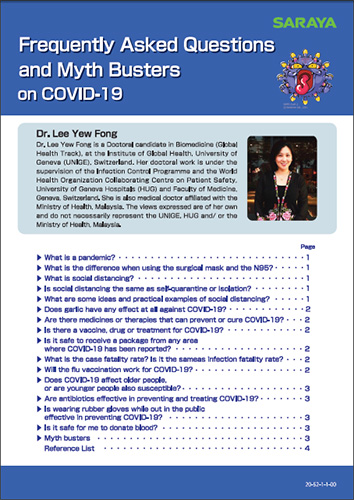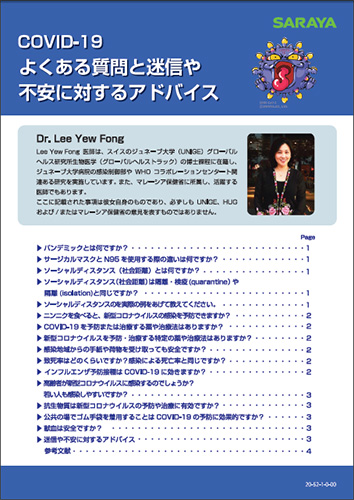- Home
- Reading Room
- Healthcare Reading Room
- Frequently Asked Questions and Myth Busters on COVID-19
Frequently Asked Questions and Myth Busters on COVID-19
|
Dr. Lee Yew Fong, MBBS, OHD, MHM Dr. Lee Yew Fong is a Doctoral candidate in Biomedicine (Global Health Track), at the Institute of Global Health, University of Geneva (UNIGE), Switzerland. Her doctoral work is under the supervision of the Infection Control Programme and the World Health Organization Collaborating Centre on Patient Safety, University of Geneva Hospitals (HUG) and Faculty of Medicine, Geneva, Switzerland. She is also medical doctor affiliated with the Ministry of Health, Malaysia. The views expressed are of her own and do not necessarily represent the UNIGE, HUG and/ or the Ministry of Health, Malaysia. |
 |
- What is a pandemic?
- What is the difference when using the surgical mask and the N95?
- What is social distancing?
- Is social distancing the same as self-quarantine or isolation?
- What are some ideas and practical examples of social distancing?
- Does garlic have any effect at all against COVID-19?
- Are there medicines or therapies that can prevent or cure COVID-19?
- Is there a vaccine, drug or treatment for COVID-19?
- Is it safe to receive a package from any area where COVID-19 has been reported?
- What is the case fatality rate? Is it the same as infection fatality rate?
- Will the flu vaccination work for COVID-19?
- Does COVID-19 affect older people, or are younger people also susceptible?
- Are antibiotics effective in preventing and treating COVID-19?
- Is wearing rubber gloves while out in the public effective in preventing COVID-19?
- Is it safe for me to donate blood?
- Myth busters
Download the article in PDF |
||
 |
 |
 |
| English | Japanese | Simplified Chinese |
What is a pandemic?1
A pandemic is the worldwide spread of a new disease that is able to infect people easily and spread from person to person in an efficient and sustained way in multiple regions. The World Health Organization’s pandemic declaration refers to the SPREAD of a disease, rather than the severity of the illness it causes.
What is the difference when using the surgical mask and the N95?
Standard square loose-fitting surgical masks are good in protecting against droplet-spread to prevent infection. However, if you were to use it in the long term, the mask will no longer be efficient in stopping the transmission of viruses. The next level of a mask is the N95, which needs to fit well for you to breathe through the filter, rather than the leaking air.
What is social distancing?
Social distancing involves remaining out of congregate settings, avoiding mass gatherings2, and maintaining ideally 3 feet (about 1 metre)3 between people.
Is social distancing the same as self-quarantine or isolation?
Self-quarantine or isolation restricts the movement of people within a certain area or zone to limit transferring and spreading infection.
To be more specific, isolation refers to separating sick people from people who aren’t sick, while self-quarantine refers to the separation and restriction of movement of people who were exposed to the virus to see if they become sick. On the other hand, social distancing has no locational constraints; rather it is a behavioural practice to lower the risk.
What are some ideas and practical examples4 3 of social distancing?
Libraries, auditorium, meeting rooms, cafeterias: If feasible, practice “1 person every 2 seats”.
Reception desks: Discussions limited to 15 minutes. Cleaning and disinfecting of reception desks to be more frequent.
While lining-up: A minimum distance of 3 feet (about 1 metre) should be maintained by those waiting in line.
Offices: Encourage teleworking when the nature of professional activities allows it, and according to the procedures established by management.
Does garlic have any effect at all against COVID-19?
There is no evidence from the current outbreak that eating garlic has protected people from COVID-19.
Are there medicines or therapies that can prevent or cure COVID-19?
While some western, traditional or home remedies may provide comfort and alleviate symptoms of COVID-19, there is no evidence that current medicine can prevent or cure the disease. The World Health Organization does not recommend self-medication with any medicines, including antibiotics, as a prevention or cure for COVID-19. However, there are several ongoing clinical trials include both western and traditional medicines.
Is there a vaccine, drug or treatment for COVID-19?
Not yet. To date, there is no vaccine and no specific antiviral medicine to prevent or treat COVID-19. However, those affected should receive care to relieve symptoms. People with serious illnesses should be hospitalized. Most patients recover thanks to supportive care. While there are several therapeutics currently in clinical trials in China and more than 20 vaccines in development for COVID-19, there are currently no licensed vaccines or therapeutics for COVID-19.
Is it safe to receive a package from any area where COVID-19 has been reported?
Yes. The likelihood of an infected person contaminating commercial goods is low and the risk of catching the virus that causes COVID-19 from a package that has been moved, travelled, and exposed to different conditions and temperatures is also low.
What is the case fatality rate? Is it the same as infection fatality rate?
The case fatality rate is the number of deaths divided by the total number of confirmed cases. Based on current data, the World Health Organization reports the global case fatality rate of COVID-19 to be 3.4%5, keeping in mind that figures are evolving and severe cases are always reported at the beginning of an outbreak because they are those we usually find first. However, scientists hope to have a more comprehensive number called the infection fatality rate over a period, which includes everyone who was infected with the virus.
Will the flu vaccination work for COVID-19?
While the influenza vaccine is not effective against the COVID-19 virus, it is highly recommended to get vaccinated each year to prevent influenza infection.
Does COVID-19 affect older people, or are younger people also susceptible?
People of all ages can be infected with COVID-19. Older people and people with pre-existing medical conditions (such as asthma, diabetes, and heart disease) appear to be more vulnerable to becoming severely ill with the virus.
Are antibiotics effective in preventing and treating COVID-19?
No, antibiotics do not work against viruses, only bacteria. However, if you are hospitalised for COVID-19, you may receive antibiotics since bacterial coinfection is possible.
Is wearing rubber gloves while out in the public effective in preventing COVID-19?
No, regularly washing or disinfecting your bare hands offers more protection against catching COVID-19 than wearing rubber gloves. You can still pick up COVID-19 contamination on rubber gloves. If you then touch your face, the contamination goes from your glove to your face and can infect you.
Is it safe for me to donate blood?6
Individuals are not at risk of contracting COVID-19 through the blood donation process since respiratory viruses are generally not known to be transmitted by donation that is conducted according to sterile collection protocols.
Myth busters7
Advice for the public based on the current evidence:
- COVID-19 can be transmitted in areas with hot and humid climates.
- Cold and snow CANNOT kill the COVID-19 virus.
- Taking a hot bath does not prevent COVID-19.
- The COVID-19 virus CANNOT be transmitted through mosquito bites.
- Hand dryers are NOT effective in killing the COVID-19 virus.
- UV lamps should not be used to sterilize hands or other areas of skin as UV radiation can cause skin irritation.
- Spraying alcohol or chlorine all over your body will NOT kill the COVID-19 virus that has already entered your body.
- At present, there is no evidence that companion animals/ pets such as dogs or cats can be infected with the COVID-19 virus.
- Vaccines against pneumonia, such as pneumococcal vaccine and Haemophilus influenza type B (Hib) vaccine, do not provide protection against COVID-19.
Reference list
- World Health Organization. WHO | What is a pandemic? [Internet]. World Heal. Organ.2020 [cited 2020 Mar 12]; Available from https://www.who.int/csr/disease/swineflu/frequently_asked_questions/pandemic/en/2.
- What Is Social Distancing? How The Coronavirus Outbreak Could Be Quelled By The Disruptive Public Health Measure [Internet]. [cited 2020 Mar 12]; Available from https://www.newsweek.com/what-social-distancing-how-coronavirus-outbreakcould-quelled-disruptive-public-health-measure-14917933.
- World Health Organization. Advice for public [Internet]. 2020 [cited 2020 Feb 5]; Available from https://www.who.int/emergencies/diseases/novel-coronavirus-2019/advice-for-public4.
- Preventive measures - Coronavirus - UNIGE [Internet]. [cited 2020 Mar 12]; Available from https://www.unige.ch/coronavirus/en/measures-prevention/5.
- WHO Director-General’s opening remarks at the media briefing on COVID-19 - 3 March 2020 [Internet]. [cited 2020 Mar 12]; Available from https://www.who.int/dg/speeches/detail/who-director-general-s-opening-remarks-atthe-media-briefing-on-covid-19---3-march-20206.
- Statement on Coronavirus and Blood Donation [Internet]. [cited 2020 Mar 12]; Available from http://www.aabb.org/advocacy/regulatorygovernment/Pages/Statement-on-Coronavirus-and-Blood-Donation.aspx
- Myth busters [Internet]. [cited 2020 Mar 12]; Available from https://www.who.int/emergencies/diseases/novel-coronavirus-2019/advice-for-public/myth-busters
Improving the sanitation, the environment, and health of the world.

© Copyright Saraya.Co.Ltd 2021 All rights reserved.